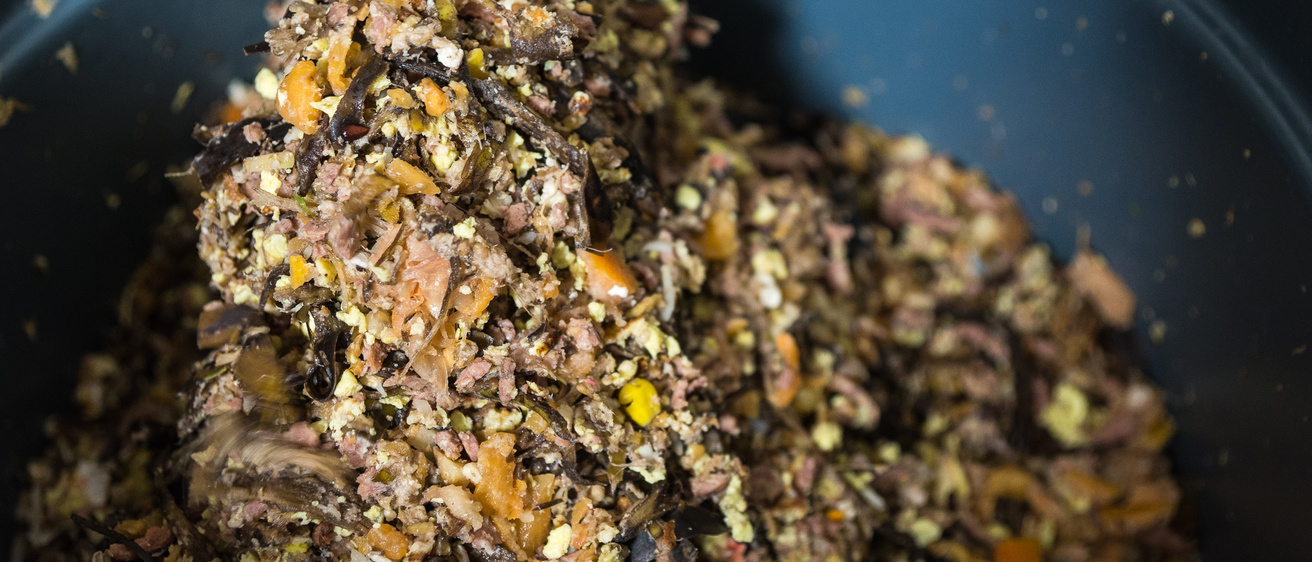Implementing sustainable practices on the University of Iowa campus requires creativity, attention to detail, and in-depth research. For Fred Kurt, operations manager at Hillcrest Market Place, improving sustainability also means saving money and increasing productivity while continuing to serve 3,250 meals to students daily.
“I was always digging for the details, doing audits finding out how much waste we have, how much is it going to cost over the course of a year, how much water usage difference will it be to try new systems,” Kurt says.
In the Hillcrest Market Place, Kurt found that University Housing and Dining could save about 1.5 million gallons of water each year by switching out the old dishwashing machine for a new system that includes a food-pulping machine. The change could save over $17,000 a year in water and detergent costs.
Less water, less waste
The food pulper, which was installed in fall 2012, grinds up leftover food waste, extracts the water, and reuses the water for the garbage disposal. This not only saves money on water, but also saves greenhouse gas emissions from the municipal City of Iowa City waste-water treatment plant.
Before the new pulper, post-consumer food waste equaled 8,533 pounds per week going into the waste-water system. After the food pulper installation, the amount of waste dropped to about 2,800 pounds per week—a 66 percent decrease. That waste now goes to the Iowa City compost operation.
“Because that pulper grinds up all the food waste and extracts the water, it reduces the weight volume by about 80 percent,” Kurt said. “Otherwise, it’s a tremendous amount of food waste.”
Some funding for the $45,000 pulper came from a Solid Waste Alternative Programs (SWAP) grant from the Iowa Department of Natural Resources. The project’s multi-faceted benefits, including saving water to reducing methane gas, were appealing to the DNR.
Campus collaboration
The grant provided $20,000 for the project. To meet the gap in funding, the Housing and Dining Sustainability Committee applied for a matching grant through the Office of the Vice President for Research and Economic Development. Writing the grant was a collaborative effort by the UI Office of Sustainability and Housing and Dining.
Liz Christiansen, director of the Office of Sustainability, was particularly happy both about the cost savings and the multiple ways in which sustainability was improved by the project.
“With the grant, along with the savings we would see with water, waste-water usage, and landfill fees, the payback should take less than three years,” she says.
The research and funding phase for the project lasted two and a half years. Although the process was lengthy, Housing and Dining wanted to be sure the system would be successful for years to come.
“One of the reasons why it took us so long from start to finish is because at first we were just going to add the pulper. But then we thought, ‘Wow, we can certainly do a lot with our new residence hall coming in,’” Kurt says.
An entire dish room remodel was required to accommodate expansions in composting and recycling for current and new students. This included a new belt system, a dishware accumulator, a new dishwasher, and the new food pulper.
Going trayless
Eliminating trays was an integral part of the new dish washing system. Going trayless encourages healthier eating habits and reduces food waste by making it more difficult for patrons to overload on food. Chemicals and water used to clean trays were eliminated. Finally, a trayless system allows for ergonomic and productivity enhancements for Market Place employees.
Some who were used to the old system complained, but as they discovered the benefits for the university and the environment, students seemed to embrace the change.
“Going trayless gave me butterflies in my stomach as we got closer to doing it, wondering what students were going to think of it,” Kurt says. “It’s been a success and we’d like to expand on that down the road with our other campus dining operations.”
The success of both the trayless initiative and the food pulper is in the numbers. According to Kurt, there has been a 5 percent reduction in food purchases by Housing and Dining, which equals almost $100,000 in savings. With the new dish room, water usage has declined from about 350 gallons per hour to 50 gallons per hour.
“Going from 350 gallons to 50, there’s not going to be a high need for the use of chemicals,” Kurt says. “We were washing 4,500 trays a day, and handling those trays takes labor, chemicals, and water.”
Model for sustainability
Other university food retail outlets are excited about the success of this project and are making plans to improve sustainability in their operations as well.
“They want to do it in Burge right away, but with the size and scale of the operations, it’s just a little bit different,” Kurt says. “It’d be a little bit more difficult to do, but we do plan and intend on doing so in the future.”
Hillcrest Market Place has served as a great model for sustainability at the university. Other sustainability improvements in recent years include eliminating Styrofoam; using compostable to-go containers; promoting healthy, local foods; and using greener cleaning products. In the greater scope, Housing and Dining is taking the university and local institutions one step closer to meeting targeted sustainability goals.
“Housing and Dining have challenged their staff to be much more sustainable and embed sustainability in their decision-making process, which is really wonderful,” Christiansen said. “They’ve really been a great model for us and other institutions in the area.”
